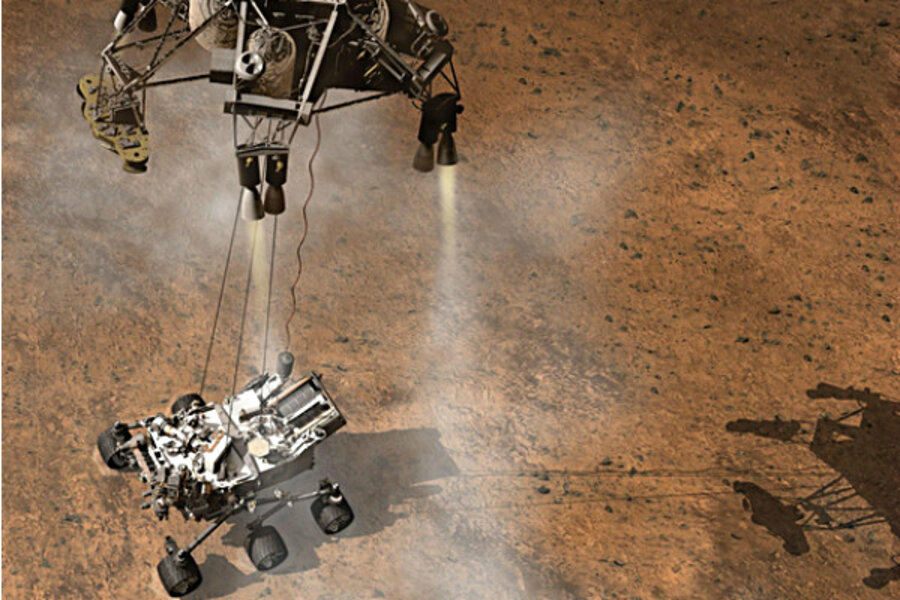MSL? EDL? A guide to NASA's Mars rover lingo.
Loading...
| Pasadena, Calif.
Fascinated by NASA's latest Mars mission and planning to tune in?
Well, good luck understanding the space agency's everyday lingo, which resembles a sort of Martian alphabet soup.
In the highly specialized world of spacecraft engineering, there are many moving parts and pieces — not to mention processes. Names and descriptions are often reduced to acronyms and abbreviations, which are faster to string together in a sentence but can end up sounding downright alien.
So if you want to know if MSL will nail the EDL and what it can do on different sols, you have to learn the language.
Even speakers acknowledge the jargon is sometimes jarring.
"It's kind of our own slang," explained Michael Watkins, mission manager of NASA's $2.5 billion Mars project set to land on Sunday night. "It's a shorthand way to talk about these very complicated systems."
He added: "Even folks from other missions have no idea what we're talking about."
There's no getting around the reality that NASA scientists and engineers are an acronym-phile bunch.
Let's start with the rover's name. In the halls of NASA's Jet Propulsion Laboratory, it's called MSL — short for Mars Science Laboratory. Spacecraft typically have technical names before being rechristened by the public through naming contests sponsored by NASA.
For example: the twin rovers Spirit and Opportunity that landed in 2004 were known as MER-A and MER-B for the longest time (MER is shorthand for Mars Exploration Rover.)
MSL did not become Curiosity until 2009 when a sixth-grader from Kansas proposed the nickname. Still, there are some hard-cores who continue to use the scientific moniker.
Curiosity is loaded with the most sophisticated instruments to study Mars' environment — with convoluted names to match. "Mastcam" refers to the pair of 2-megapixel color cameras on the rover's "head." ''SAM" — short for Sample Analysis at Mars — is the mobile chemistry lab designed to sniff for carbon compounds. "ChemCam" stands for Chemistry and Camera, otherwise known as the rock-zapping laser. And "RAD"? That's the radiation detector.
Before Curiosity can start science experiments, it must first survive an intense EDL — entry, descent and landing — or as NASA has come to call it: Seven minutes of terror.
Signals are received through the DSN, or Deep Space Network, a worldwide network of antenna dishes that communicates with interplanetary spacecraft. Nominal means A-OK. Not so for anomaly (translation: Houston, we have a problem.)
The dizzying naming system even extends to time. It takes Earth 24 hours to spin on its axis — the definition of a day. Mars spins more slowly than Earth — taking 24 hours and 39 minutes. To distinguish between Earth and Mars time, a Martian day is called a sol, Latin for "sun." Yesterday on Mars is yestersol.
Newcomers often find there's a steep curve to master the technical language.
"It takes some time to pick it up," said Ken Farley, a professor at the California Institute of Technology who is participating on his first space mission.
Luckily, Farley said new shorthand words are added to the mission's internal website.
Before Spirit and Opportunity launched, cultural psychologists worked with scientists to come up with a better way to communicate. The rules of Mars-speak put in place back then still lives on today.
JPL scientist Deborah Bass, who worked on that mission, said it's important to talk with precision. But she said it's also essential not to alienate fans.
"We're so jazzed about what we do," Bass said. "We can forget that not everybody has the same fundamental background as we do."
Nowhere will extraterrestrial vocabulary fly faster than in the JPL mission control room on landing day. If you find it hard to keep up, just look for the cheers — or tears.
___







